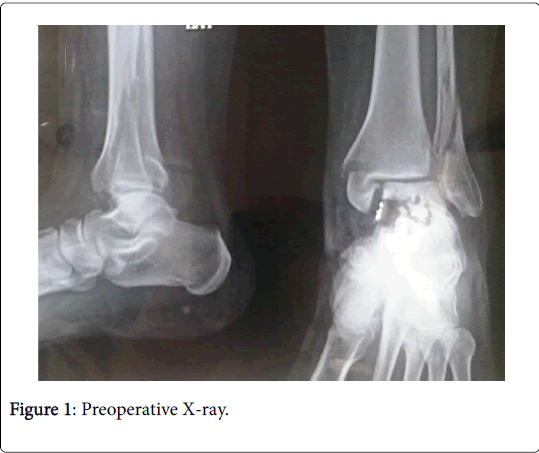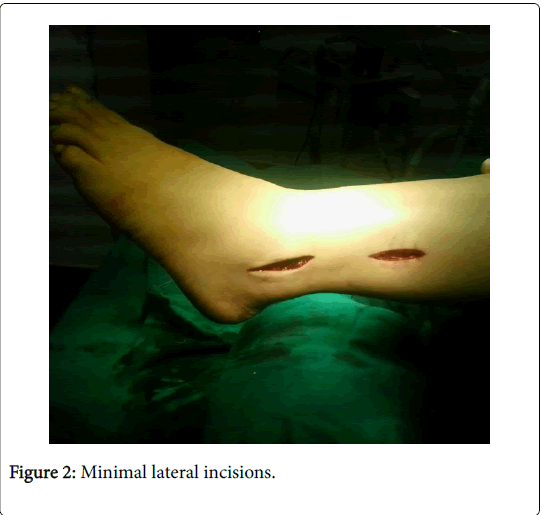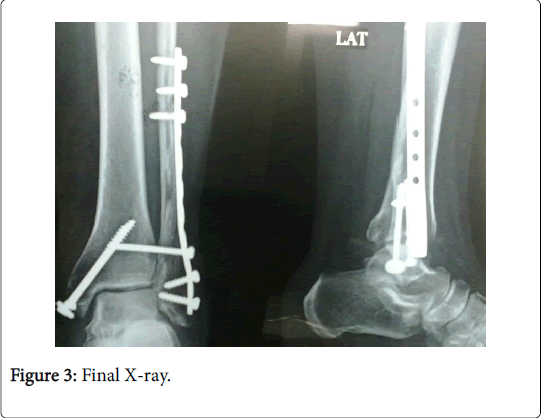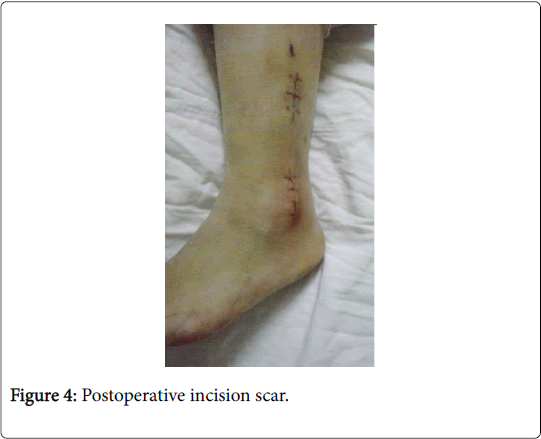The Avoidance of Soft Tissue Complications Following Treatment of Pott's Fractures with Comminuted Lateral Malleolus in Diabetic Patients through a Minimal Invasive Surgery
Received: 27-Jan-2018 / Accepted Date: 05-Feb-2018 / Published Date: 12-Feb-2018 DOI: 10.4172/2329-910X.1000261
Abstract
Background: Diabetes mellitus (DM) is a well recognized risk factor for infection. The Infection rates in diabetic patients undergoing open reduction and internal fixation of ankle fracture can be as high as 60%.
Methods: Between February 2011 and June 2013, this prospective study was performed in 20 patients presented by bimalleolar pott's fracture in diabetic patients with comminuted fracture of the lateral malleolus. The patients underwent internal fixation through minimal incisions.
Results: Out of twenty cases with pott's fractures treated with a minimal invasive surgery, 19 lateral malleolus united and 20 medial malleolus. According to skin condition, only two patients had superficial early postoperative infection.
Conclusions: The advantage of this surgery is the avoidance of soft tissue complications through minimal incisions with minimal risk of infection with high rate of bony union and more cosmetic.
Keywords: Pott's fracture; Minimal incision; Diabetic patients
Introduction
Diabetes mellitus (DM) is a well recognized risk factor for infection. The Infection rates in diabetic patients undergoing open reduction and internal fixation of pott's fracture can be as high as 60%. Failed treatment of infection in diabetic patients with pott's fracture can lead to amputation in 42% of the patients and mortality rate is 11% [1-3].
Ankle fractures treated operatively in patients who had diabetes mellitus had significant increases in hospital mortality, postoperative complications, length of stay, rate of non routine discharge and total hospital charge as compared to patients without diabetes mellitus [4].
Patients and Methods
Between February 2011 and June 2013, this prospective study was performed in 20 patients presented by bimalleolar pott's fracture in diabetic patients with comminuted fracture of the lateral malleolus at Mansoura emergency hospital. The study was done under the local ethical committee. Also, an informed consent was obtained from all participants. Fifteen patients (75%) were female and 5 (25%) were male. The mean age of patients was 50.2 years (Range: 38 to 63 years). Twelve patients had a right sided and eight a left sided fracture. All patients had suffered a trauma in the form of twisting injuries of the ankle in 14 patients and falls in 6 cases. All patients underwent a full radiological evaluation (Figure 1).
All patients had Danis-Weber classification Type II and type III fracture. All patients have comminuted fracture of lateral malleolus. All patients were diabetic and have done fasting and postprandial blood sugar and HbA1c test and received their antidiabetic medical treatment in the form of insulin injection preoperative and postoperative. All patients underwent a full clinical evaluation and the dorsalis pedis pulse was good and their peripheral circulation. Also, the sensation over the foot and ankle was normal in all patients. There were no Charcot cases.
Surgical technique
The patients were operated in supine position under spinal anesthesia. The surgical technique consisted of application of basic reduction and fixation methods. On the lateral side two minimal standard incisions were made, each of them on both sides of the fracture ends (Figure 2).
Full thickness skin flaps were prepared until the fibula under control of bleeding by diathermy. The fracture site was not exposed. In our study we used the one third tubular plates which are contoured. These plates are available with different holes. The plate was introduced from the distal incision over the lateral malleous then the plate was placed on the shaft of the fibula. By using fluoroscopy, we verified the plate position before definitive fixation. The plate was first fixed to the distal fragment of the fibula with screws then traction and manipulation for reduction of the comminution and assessment by using fluoroscopy then hold the plate through the proximal incision and fix the plate with 3.5 cortical screws. Through a minimal incision on the medial side; the periosteom is removed by diathermy.
The medial malleolus was fixed by percutaneous 2 partial cancellous screws 4 mm with washers. One tricorical syndesmotc screws used in all patients. The surgical wounds were closed. All patients have taken postoperative antibiotic. All patients were discharged in a cast brace or ankle-foot orthosis. All patients kept non-weight bearing for up to 12 weeks until bony healing and protected in ankle-foot orthosis for an additional 4 to 8 weeks. Patients are seen at weekly intervals and then biweekly to monitor the wound for breakdown and the fracture healing or implant failure radiographically.
Results
The follow-up of all 20 patients ended after a mean period of 16 months (Range: 13-22 months). The comminuted fracture of the lateral maleolus showed bony union (Range: 10-16 weeks) through radiological evaluation. Out of twenty cases 19 lateral malleolus united and 20 medial malleolus (Figure 3).
The mean fracture healing time was 12 weeks after operation. 19 patients had radiological union (95%). One patient (5%) had fibrous non-union which was diagnosed radiologically and clinically with good alignment without functional disability and was asymptomatic.
According to skin condition, only two patients had superficial early postoperative infection. The patients were uncontrolled diabetic patients however they had multiple daily insulin injections regimen; one infected wound was on the lateral side and another one was on the medial aspect, which was controlled by oral antibiotics and repeated daily dressing. There were no serious skin complications especially on the lateral side like deep infection or wound dehiscence.
Out of 20 patients 3 had near normal range of motion of the ankle with terminal restriction of ankle movement. 17 patients (85%) were totally pain free and were satisfied with the procedure. There were no intraoperative complications.
One patient suffered fibrous nonunion of the lateral malleolus without implant failure. All patients were satisfied with incision scars (Figure 4).
Discussion
Pott's fractures are associated with early complications which are related to the surrounding soft tissue envelope owing to anatomical reasons. Only subcutaneous tissue covers both malleoli. The delayed healing time of soft tissue due to poor vascularity and the high incidence of neuropathy. Ankle fractures in diabetic patients undergoing surgery have a high risk of soft tissue complications especially in presence of long incisions and long time operation. Unstable ankle Potts's fractures in diabetic patients should be treated operatively; however, the recommendations have been made in some reports describing methods of supplemental fixation rather than through traditional open reduction and internal fixation. Schon and Marks in their study recommended avoiding the use of bone-holding clamps and using either manual traction or a femoral distractor to assist with the reduction [5]. In pott's fracture with comminuted lateral malleolus and with traditional open reduction and internal fixation surgery it may need long incision on the lateral side and long time surgery and this may be associated with high risk of infection and wound complications. In this study we used a minimal invasive surgical technique either during lateral malleolus or medial malleolus fixation to avoid long incisions and its drawbacks on soft tissue and bone healing. With this technique out of 20 patients there were only 2 cases with superficial infection and these two patients were uncontrolled diabetic patients however they had multiple daily insulin injections regimen. The infection subsided with local wound care and oral antibiotics. According to fracture healing there were high rate of bony union 95%. Only one patient complicated with fibrous nonunion on the lateral malleolus which was diagnosed radiologically and clinically. No implant failure was reported. The incidence of union increased with good skin condition. Blotter et al reported in his study looked 13 complications at 21 patients, including 7 infections, 3 losses of fixation, 1 case of reflex sympathetic dystrophy, 1 wound dehiscence, and 1 plantar ulcer. Two of the infections complicated by transtibial amputations [6]. Costigan et al reported 14 complications at 84 patients, including 10 infections and 4 cases of Charcot arthropathy. Patients with absent pedal pulses or peripheral neuropathy were found to have significantly high risk of complications [7]. The advantages of this technique are good soft tissue healing, minimize the risk of infection and high rate of bony union. All patients resumed preinjury activities. All patients were satisfied with the incision scar.
Conclusion
Minimal invasive surgery for treatment of pott's fracture with comminuted lateral malleolus in diabetic patients is a promising operation. The advantage of this surgery is the minimal incisions with avoidance of soft tissue complications with high rate of bony union and more cosmetic.
Conflict of Interest
There are no conflicts of interest.
Funding
Nil.
Ethical approval
The study was done under the local ethical committee of our institution.
Informed consent
Informed consent was obtained from all individual participants included in the study.
References
- Zalavras CG, Christensen T, Rigopoulos N, Holtom P, Patzakis MJ (2009) Infection following operative treatment of ankle fractures. Clin Orthop Relat Res 467: 1715-1720.
- White CB, Turner NS, Lee GC, Haidukewych GJ (2003) Open ankle fractures in patients with diabetes mellitus. Clin Orthop Relat Res 414: 37-44.
- Mc Cormack RG, Leith JM (1998) Ankle fractures in diabetics. Complications of surgical management. J Bone Joint Surg Br 80: 689-692.
- Ganesh SP, Pietrobon R, CecÃlio WA, Pan D, Lightdale N, et al. (2005) The impact of diabetes on patient outcomes after ankle fracture. J Bone Joint Surg Am 87: 1712–1718.
- Schon LC, Marks RM (1995) The management of neuroarthopathic fracture-dislocations in the diabetic patient. Orthop Clin North Am 26: 375–392.
- Blotter RH, Connolly E, Wasan A, Chapman MW (1999) Acute complications in the operative treatment of isolated ankle fractures in patients with diabetes mellitus. Foot Ankle Int 20: 687–694.
- Costigan W, Thordarson DB, Debnath UK (2007) Operative management of ankle fractures in patients with diabetes mellitus. Foot Ankle Int 28: 32–37.
Citation: Maaty MT, Khalek MA (2018) The Avoidance of Soft Tissue Complications Following Treatment of Pott's Fractures with Comminuted Lateral Malleolus in Diabetic Patients through a Minimal Invasive Surgery. Clin Res Foot Ankle 6: 260. DOI: 10.4172/2329-910X.1000261
Copyright: ©2018 Maaty MT, et al. This is an open-access article distributed under the terms of the Creative Commons Attribution License, which permits unrestricted use, distribution, and reproduction in any medium, provided the original author and source are credited.
Select your language of interest to view the total content in your interested language
Share This Article
Recommended Journals
Open Access Journals
Article Tools
Article Usage
- Total views: 7230
- [From(publication date): 0-2018 - Jun 11, 2025]
- Breakdown by view type
- HTML page views: 6371
- PDF downloads: 859




